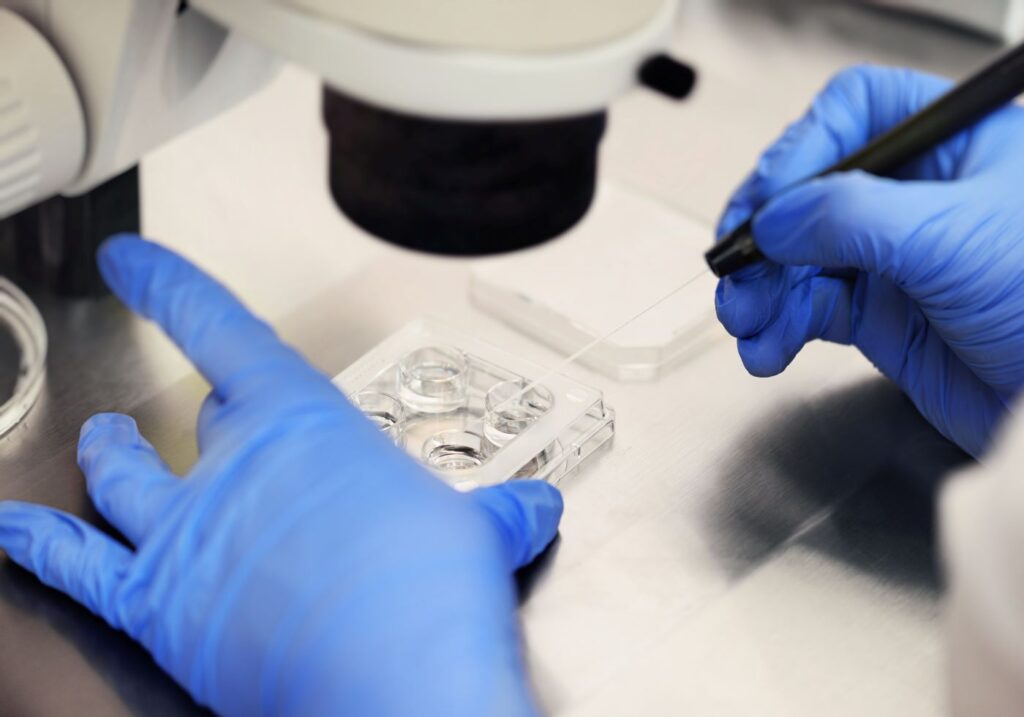What does it mean to be human?
The most fundamental philosophical question made headlines recently as issues like AI and gene editing have forced communities and politicians to come to terms with who they think counts as a person. For example, earlier this year, the Alabama Supreme Court declared that frozen embryos created through in vitro fertilization (IVF) were human children entitled to the state’s protection under its wrongful death statute. Though the Alabama legislature passed a temporary fix allowing IVF clinics to continue operating with immunity, legislators from both parties have articulated the need to define “personhood”—who among us has rights, protections, and privileges that the government is bound to uphold.
Yet personhood is just the kind of question that defies consensus. The hope for any sort of agreement or any negotiation on a legal—or even a cultural—definition of personhood seems increasingly dim in our current, hyperpolarized political context.
Principled pluralism offers positive solutions to today’s political polarization over culture war issues such as religious freedom, LGBTQ+ rights, education, parental responsibility, and the like. But what does this perspective have to offer when pluralism isn’t an option? When the issues are such that competing perspectives literally cannot coexist?
Start your day with Public Discourse
Sign up and get our daily essays sent straight to your inbox.In response, many Christians have either adopted or become sympathetic to approaches that reject traditional liberalism in favor of those that more actively enforce their view of God’s moral order.
But this particular prescription has side effects I am not prepared to swallow. No, we cannot—even if we think it wise—through sheer power impose our view of the good on a nation that is becoming increasingly diverse. Nor do we need to hopelessly abandon our society to its own dissolution.
We can and should, as Stephanie Summers, the CEO of the Center for Public Justice likes to say, “Love our neighbors through politics” and call on the state to fulfill its duties to protect as many people as possible. However, for issues that touch on such deeply divisive, personal matters as reproductive technologies and our human future, where opposing perspectives are irreconcilable, we need a new approach. The good news is that this approach is rooted in Scripture and the vision of the good life—of human flourishing—the Lord has revealed to his people.
Rather than steeping our arguments about bioethics—whether concerning reproductive ethics, AI, or end-of-life care—in a modern, liberal emphasis on the rights of the individual, we should instead develop public policy perspectives that focus on our network of interdependencies and a view of the common good that is also central to a biblical understanding of shalom, or human flourishing.
A Common Good Framework for Bioethics
A communal emphasis on shalom gives us a framework for talking about bioethics and public policy that bypasses a zero-sum fight over individual rights and autonomy, transcending disagreements about personhood, and instead focusing our attention on the right role of government in shaping a society in which all can flourish.
The field of bioethics grapples with the question of how to protect and promote the inherent dignity of the human person. Many bioethical questions are intensely personal—such as the use of fertility treatments or navigating end-of-life care for loved ones. Others are professional—informing, for example, how a medical professional can fulfill her obligations to her patient. In these instances, while federal and state guidelines offer broad legal frameworks, they also provide significant flexibility, allowing individuals to make decisions based on their own ethical, religious, or moral beliefs.
But some bioethics issues—those often termed “public bioethics”—transcend the domains of family and workplace and should be regulated directly by state or federal governments.
In his book What It Means to Be Human: The Case for the Body in Public Bioethics, Carter Snead defines public bioethics as the governance of science, medicine, and biotechnology in the name of ethical goods. Sadly, the current landscape of laws and policies in the realm of bioethics did not develop out of a well-reasoned, philosophical foundation. Rather, as Snead asserts, “The story of American bioethics is a succession of political and legal reactions to the reported use, abuse, and exploitation of the weakest and most vulnerable members of the human population.”
This reactionary history is important, because it explains, in part, how in areas of abortion, end-of-life care, and other bioethical issues, we ended up at an impasse over whose individual rights take precedence. A few key moments solidified our national commitment to a view of human dignity rooted in radical autonomy, which guides our current discourse in public bioethics. The first occurred in the years following World War II. In response to the moral atrocities of Nazi Germany, the international community passed the Nuremberg Code in 1947 and the Universal Declaration of Human Rights in 1948. Though a positive advance overall, these declarations are tethered to an Enlightenment understanding of human nature that emphasizes the individual without acknowledging the relationships and community that are vital to human dignity and flourishing.
The second moment helped to catalyze the entire discipline of public bioethics in the United States. In the early 1970s, the media uncovered a profound violation of dignity experienced by African American men enrolled in a medical research study in Tuskegee, Alabama. For decades, researchers failed to provide participants with known treatments for syphilis. Formulated as a response to this severe breach of research ethics, the government-sponsored Belmont Report elaborated four foundational principles of bioethics, which several government agencies adopted to protect individuals from research misconduct. As these principles have evolved, the concept of autonomy has emerged as preeminent among the four, a kind of lowest common denominator principle on which all can agree. The result is that, rather than autonomy being merely one component of what it means to be human, human dignity has become synonymous with autonomy, not only in the culture, but also as adjudicated in the courts. Layered on top of this reductionist approach to human dignity in biomedicine is our commitment as a culture to what Robert Bellah, Charles Taylor, and others have termed “expressive individualism,” the idea that our individual autonomy and freedom to craft our own identities and purpose are the key, defining features of our humanity.
Despite having different metaphysical commitments, the public Christian conversation about human dignity has operated under the same individualistic assumptions. In the case of abortion, for example, we have focused our attention on the individual rights of the unborn and, in many cases, have ignored the larger network of relationships and circumstances in which both the child and the mother are involved. As a result, we have become locked into trench warfare, pitting the unborn’s right to life against a woman’s right to autonomy and self-expression.
Though the Dobbs decision was a watershed that allowed abortion to be limited in the states in which pro-life advocates hold a majority, the fact that abortion has been a winning issue for Democrats in the past few election cycles has generated some fear that we have won the battle only to lose the war.
We cannot successfully fight for human dignity on humanist, individualist terms. Instead, I propose that we return to first principles. For the Christian, that means beginning with what Scripture says about personhood and human dignity.
The starting point for any conversation among Christians about bioethics and human dignity, is Genesis 1–2 and the doctrine of the imago Dei. For the average American Christian the logic is simply this: All individual human beings are made in God’s image, which, though marred by sin, nevertheless endows each member of the species with worth and dignity. Therefore, any assault on the dignity of any member of the species should be prohibited.
Because the root of dignity lies with the creator rather than any attributes or skills of the created, all members of the species possess the same inherent worth—no matter how small, disabled, or old, and no matter how newly conceived. Every creature has infinite worth because they are made in the image of the creator of the cosmos.
This is a beautiful, necessary, and yet insufficient foundation for human dignity, an incomplete view of the worth of the human person as grounded in the image of God. Throughout church history, many theologians have understood the image of God not only in substantive terms, similar to the logic just described, but also in relational and functional terms. The relational view of being made in the image of God emphasizes the idea that humans reflect God’s image through their capacity for relationships, both with God and with one another, mirroring the relational nature of the Trinity. The functional view emphasizes God’s role in the universe and our calling to exercise dominion over creation alongside him. These two aspects of what it means to be made in the image of God—relationship and responsibility—have been neglected in much of the West’s understanding of human rights and human dignity, but they are no less important.
This view of human dignity begins to sound a lot more like human flourishing and moves us to the biblical aspiration of shalom. Shalom, or human flourishing, can only take shape in community. After all, the story of what it means to image God does not stop with Genesis. As the narrative continues into Exodus and Leviticus, the Lord makes it clear that his purpose for the nation of Israel is to reflect—to image—his steadfast love and mercy to the nations as a community. They are, as he says in Exodus 19, to be a kingdom of priests—mediating his presence to a watching world. As a result, as many scholars have noted, the law elaborated in the Torah is rooted in the very nature and character of God, which is relational at its core. Though this is apparent throughout the Torah, Leviticus 19 particularly emphasizes that the love of God is directly expressed in our responsibilities toward one another.
God’s purpose throughout the entire biblical narrative is to call us as unique individuals into a community that reflects his character and glory to the world. We simply cannot fully image God apart from our relationships and responsibilities to one another. Thus, our consideration of bioethics and public policy must include the intertwined goods of the dignity of the individual human person as rooted in relationship and responsibility, which includes but is so much more than a bounded autonomy.
This view of human dignity will inevitably complicate the application of bioethics to public policy. Protecting individual human rights, particularly the right to life, is a more narrow call, and is a clear responsibility of the state. Promoting human flourishing as communally envisioned involves multiple spheres of responsibility, including not only the state, but also various civil society institutions, churches, families, and more. Determining whether and when public policy is an appropriate tool for promoting the flourishing of our communities requires nuance and discernment.
But this rich, thick understanding of human dignity as fully realized in the context of a flourishing society provides a bridge for developing consensus policy solutions even across major theological and philosophical differences about personhood.
To illustrate, let’s examine two cultural examples.
“Assisted Suicide” and a Common Good Framework
In the U.S., eleven jurisdictions have legalized assisted suicide, and more than a dozen states will consider legislation either to expand or to legalize assisted suicide this year. The practice has been legal throughout Canada since 2016 under the term “Medical Aid in Dying” or MAiD. At first, only the terminally ill were eligible, but the law in Canada has since expanded to include those experiencing any “grievous and irremediable” condition.
Establishing the right to die is a natural extension of a narrow emphasis on privacy and autonomy as the main tenets of human dignity, and the fight for and against assisted suicide has largely been waged on these individualistic terms. But what would it look like to consider the individual person as embedded in a web of social relations, by which we have particular obligations? How might that help us come to some consensus about assisted suicide?
Consider the example of Canadians gaining access to assisted suicide for the “grievous and irremediable” situation of something like homelessness, which was actually documented for a woman we’ll call Nancy. If we see human dignity in individualistic terms, then we are stuck arguing that our view of human dignity (“all life matters”) trumps the view of human dignity as autonomy. In other words, we must violate someone’s autonomy—the perceived right to develop their own view of the human person—to protect their life. In our current expressive individualistic culture, this line of argument seems futile.
But what if we instead articulate a view of human dignity that acknowledges that Nancy’s flourishing has been diminished by our collective failure to meet her needs? Instead of fighting dignity-as-autonomy, we begin to support both the civil society institutions and public policies that promote Nancy’s dignity as a member of a community—and we acknowledge our obligations to her as part of it.
Practically, this approach leads us to patient, incremental political strategies that include thoughtful coalition building—for instance, working alongside co-belligerents like the many disability rights groups who oppose assisted suicide. In many cases, lack of access to quality medical, hospice, and end-of-life care drives the desire to pursue assisted suicide. What if, instead, we work to improve healthcare access and quality hospice care to make assisted suicide unthinkable?
Approaching assisted suicide with this common good framework provides an opportunity for us to live a whole life ethic that seeks to make euthanasia unthinkable—not in an instrumental manner that uses “whole life” policies as a means to an end, but in a way that overflows from an expansive view of human dignity rooted in the network of interdependencies for which we were created.
This rich, thick understanding of human dignity as fully realized in the context of a flourishing society provides a bridge for developing consensus policy solutions even across major theological and philosophical differences about personhood.
A Second Cultural Example: A Common Good Framework Applied to IVF
Through the lens of this wider frame of human dignity based not only on individual rights but also on our network of relationships and obligations, unregulated IVF should also give us some pause. Set aside for a moment the moral status of the embryo, the thorny issue of personhood around which there is so much disagreement. There are several ways that IVF is currently practiced that have the potential to subvert human flourishing.
First, in order to choose embryos that have the best chance of survival in utero, scientists routinely screen embryos for abnormalities. Embryos with obvious defects are passed over for those with a better statistical chance of survival. During this process, the embryos can also be screened for the presence of favorable or unfavorable genotypes, including sex and other genetically determined traits. Many IVF clinics offer this service even for families who are not infertile but simply want to control the sex or some other feature of their child.
Federal regulations limiting gender selection and any other kind of non-medical genetic tests on an embryo would push against the trend of reducing children to mere products of technological manipulation. Such regulations would not require declaring that the embryo is a person in law—or banning IVF altogether—but would call parents to fulfill their responsibilities toward their children, thereby promoting both their dignity and the dignity of their children. The view that the commodification of children is morally wrong is a value that we share with friends and neighbors outside the Christian community, providing opportunities for coalition building and real political progress.
Second, IVF is often used by women who do not want to pay the “motherhood penalty” in their careers. For biological reasons, the eggs a woman’s body releases when she is young have fewer genetic abnormalities than those released later in life. Women can freeze their “young” eggs and use IVF as a safer way to have children after their career is well established.
But having children later in life has its own challenges. As a testament to this reality, many private adoption agencies limit adoption to parents under fifty. Though not required by law, such provisions acknowledge the lifelong commitment parents make to a child, the very real emotional and physical strain of parenting, and the responsibilities that that child will have to care for aging parents.
If we consider the broader dignity of the mother and the child, and the society shaped by their family, a better solution to the dilemma faced by women who want to pursue career and family would be to work to mitigate the perceived motherhood penalty paid by women who have children early in their careers. And, to acknowledge the obligations between parents and children, we could enact regulations limiting IVF to women under fifty. This advocacy would not require consensus about the moral status of the embryo, but it would invite collaboration across religious and other moral differences in pursuit of a better future for mothers and children alike.
Hope and Progress
Of course, IVF is just one area in which the fertility industry needs regulation. The inconsistent application of the widely held Christian view of the value of all life has sadly interfered with our ability to build coalitions that have the potential to deliver meaningful policy results, even beyond issues of life, death, and reproductive health.
Nonetheless, recent momentum in protecting children and families bodes well. For instance, measures like using age verification laws to limit minors’ access to pornography, and efforts to modestly expand child tax credits to support low-income families, have inspired meaningful coalitions working across partisan and religious differences. These can serve as models for the many ways policy can be constructed to honor the relationships and responsibilities for which we are made.
The public bioethics conversations of the twenty-first century will be much more nuanced and complicated than the abortion debate of the last fifty years. If we want to speak thoughtfully about how these and other technologies are shaping our future, we will need to move beyond a reductionist approach to human dignity. A focus on human dignity that elevates the biblical picture of communal flourishing will enable us to develop relationships and build coalitions that ensure we have a trusted seat at the table to influence the regulation of these complex issues for the common good.
Image by Evgeniy Kalinovskiy and licensed via Adobe Stock.














